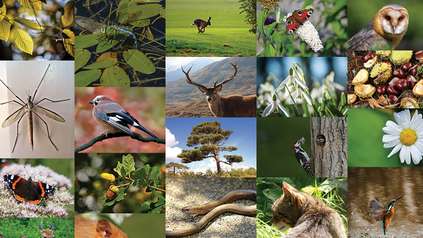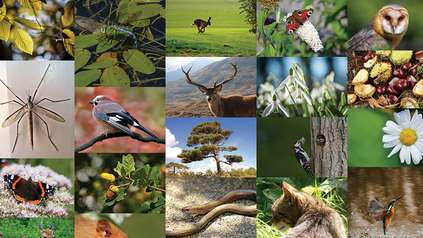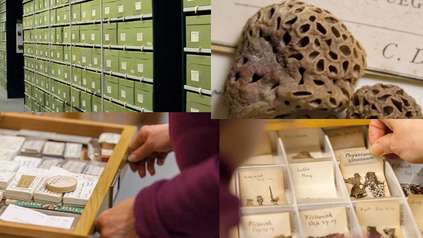Huge step forward in decoding genomes of small species
For the first time, scientists have read the whole genetic code of one single tiny mosquito. Traditionally, it has been difficult to extract enough DNA from insects and other small organisms to build a high quality genome for a single individual. Scientists from the Wellcome Sanger Institute and Pacific Biosciences worked in partnership to advance technology and lower the starting amount of DNA needed to just ‘half a mosquito-worth’, producing the first high quality whole genome of a single mosquito.
The results, reported in Genes open the door to understanding the true genetic diversity of insects and other arthropods, which comprise the most diverse animal group in the tree of life.
In 2018, collaborating organisations around the world officially launched the Earth BioGenome Project, a global mission to sequence all 1.5 million known species of animals, plants, protozoa and fungi on Earth. The Earth BioGenome Project will ultimately create a new foundation for biology to drive solutions for preserving biodiversity and sustaining human societies.
When studying the biology of a species, the genome of a single individual can be used as a reference to explore the genetic differences attributing to varying susceptibility to disease, fitness and adaptation within others of the same species.
However, it is much easier to extract DNA and sequence the genome of some species over others. In particular, it has not been possible to assemble the genome from single small organisms such as insects using current sequencing technology. This leaves the genetic codes of individual insects and other similar-sized species inaccessible.
Until now, scientists have had to pool the DNA of multiple individuals of the same species, or inbreed them to produce genetically related individuals, in order to gather enough DNA to build a genome. This creates challenges when putting the genetic sequence back together again after it has been sequenced, as it can be difficult to know which genetic fragment came from which individual, resulting in genome sequences full of gaps and errors.
In the new study, Sanger Institute researchers worked with scientists at the sequencing technology provider, Pacific Biosciences (PacBio) to produce the first high-quality genome from a single insect using new technology that reduces the starting DNA needed.
“This advancement in sequencing technology is vital to decoding the genomes of a huge number of species in the tree of life, giving us greater power to completely understand genetic diversity within even the tiniest species.”
Dr Mara Lawniczak Co-lead author from the Wellcome Sanger Institute
Sanger scientists extracted DNA from a single Anopheles coluzzii mosquito and sent it to PacBio in the United States.
To reduce the amount of starting DNA required for genome sequencing, the PacBio team tweaked the preparation chemistry for genomic sequencing. They removed two steps from the process that result in the loss of DNA: shearing – cutting the DNA fragments into certain size ranges, and size selection – removing the unwanted small fragments.
The team were able to generate a high quality genome from just 100 nanograms of DNA – about half a mosquito’s worth – which is over an order of magnitude less than the 5 micrograms of DNA previously required.
The resulting genome was quick to assemble, complete and accurate. As a result of the complete genomic picture, nearly half of the previously unplaced DNA fragments for this mosquito species could now be placed within the correct chromosomal context.
“This has been a real team effort and we’ve thoroughly enjoyed the collaboration in developing this protocol. It’s a great example of the significant advances we can bring to the scientific community when academia and industry work together.”
Dr Jonas Korlach Chief Scientific Officer at Pacific Biosciences and co-lead author of the study
This advance could have positive potential for humans as well, for example in the future it could be possible to assemble the whole genetic code of a patient’s cancer, from a single biopsy.
“The sequencing technology also shows promise for reading the whole genetic code of an individual patient’s cancer biopsy. 100 nanograms of DNA collected with a needle prick could be enough to give a detailed view of the cancer’s genetics and inform targeted therapies for that specific patient.”
Dr Peter Campbellfrom the Wellcome Sanger Institute who was not involved in the study
More information
Publication:
Sarah Kingan et al. (2019) A high-quality de novo genome assembly from a single mosquito using PacBio sequencing. Genes. DOI : 10.3390/genes10010062
Funding:
This study was supported by MRC (G1100339), Wellcome (206194/Z/17/Z; WT207492) and PacBio.
Selected websites
About Pacific Biosciences
Pacific Biosciences of California, Inc. (NASDAQ:PACB) offers sequencing systems to help scientists resolve genetically complex problems. Based on its novel Single Molecule, Real-Time (SMRT®) technology, Pacific Biosciences’ products enable: de novo genome assembly to finish genomes in order to more fully identify, annotate and decipher genomic structures; full-length transcript analysis to improve annotations in reference genomes, characterize alternatively spliced isoforms in important gene families, and find novel genes; targeted sequencing to more comprehensively characterize genetic variations; and real-time kinetic information for epigenome characterization. Pacific Biosciences’ technology provides high accuracy, ultra-long reads, uniform coverage, and the ability to simultaneously detect epigenetic changes. PacBio® sequencing systems, including consumables and software, provide a simple, fast, end-to-end workflow for SMRT Sequencing. More information is available at www.pacb.com
Wellcome Sanger Institute
The Wellcome Sanger Institute is one of the world’s leading genome centres. Through its ability to conduct research at scale, it is able to engage in bold and long-term exploratory projects that are designed to influence and empower medical science globally. Institute research findings, generated through its own research programmes and through its leading role in international consortia, are being used to develop new diagnostics and treatments for human disease. Find out more at www.sanger.ac.uk or follow us @sangerinstitute on Twitter, Facebook and LinkedIn, or keep up with our Blog.
Wellcome
Wellcome exists to improve health by helping great ideas to thrive. We support researchers, we take on big health challenges, we campaign for better science, and we help everyone get involved with science and health research. We are a politically and financially independent foundation.





